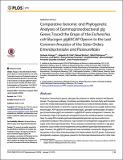Por favor, use este identificador para citar o enlazar a este item:
http://hdl.handle.net/10261/110636COMPARTIR / EXPORTAR:
 SHARE SHARE
 CORE
BASE CORE
BASE
|
|
| Visualizar otros formatos: MARC | Dublin Core | RDF | ORE | MODS | METS | DIDL | DATACITE | |

| Campo DC | Valor | Lengua/Idioma |
|---|---|---|
| dc.contributor.author | Almagro, Goizeder | - |
| dc.contributor.author | Viale, Alejandro M. | - |
| dc.contributor.author | Montero, Manuel | - |
| dc.contributor.author | Rahimpour, Mehdi | - |
| dc.contributor.author | Muñoz Pérez, Francisco José | - |
| dc.contributor.author | Baroja-Fernández, Edurne | - |
| dc.contributor.author | Bahaji, Abdellatif | - |
| dc.contributor.author | Zúñiga, Manuel | - |
| dc.contributor.author | González-Candelas, Fernando | - |
| dc.contributor.author | Pozueta Romero, Javier | - |
| dc.date.accessioned | 2015-02-13T11:29:10Z | - |
| dc.date.available | 2015-02-13T11:29:10Z | - |
| dc.date.issued | 2015-01-21 | - |
| dc.identifier | issn: 1932-6203 | - |
| dc.identifier.citation | PLoS ONE 10(1): e0115516 (2015) | - |
| dc.identifier.uri | http://hdl.handle.net/10261/110636 | - |
| dc.description.abstract | © 2015 Almagro et al. Production of branched α-glucan, glycogen-like polymers is widely spread in the Bacteria domain. The glycogen pathway of synthesis and degradation has been fairly well characterized in the model enterobacterial species Escherichia coli (order Enterobacteriales, class Gammaproteobacteria), in which the cognate genes (branching enzyme glgB, debranching enzyme glgX, ADP-glucose pyrophosphorylase glgC, glycogen synthase glgA, and glycogen phosphorylase glgP) are clustered in a glgBXCAP operon arrangement. However, the evolutionary origin of this particular arrangement and of its constituent genes is unknown. Here, by using 265 complete gammaproteobacterial genomes we have carried out a comparative analysis of the presence, copy number and arrangement of glg genes in all lineages of the Gammaproteobacteria. These analyses revealed large variations in glg gene presence, copy number and arrangements among different gammaproteobacterial lineages. However, the glgBXCAP arrangement was remarkably conserved in all glg-possessing species of the orders Enterobacteriales and Pasteurellales (the E/P group). Subsequent phylogenetic analyses of glg genes present in the Gammaproteobacteria and in other main bacterial groups indicated that glg genes have undergone a complex evolutionary history in which horizontal gene transfer may have played an important role. These analyses also revealed that the E/P glgBXCAP genes (a) share a common evolutionary origin, (b) were vertically transmitted within the E/P group, and (c) are closely related to glg genes of some phylogenetically distant betaproteobacterial species. The overall data allowed tracing the origin of the E. coli glgBXCAP operon to the last common ancestor of the E/P group, and also to uncover a likely glgBXCAP transfer event from the E/P group to particular lineages of the Betaproteobacteria. | - |
| dc.description.sponsorship | This research was partially supported by the grant [BIO2010-18239] from the Comisión Interministerial de Ciencia y Tecnología and Fondo Europeo de Desarrollo Regional (Spain). MR acknowledges a pre-doctoral JAE fellowship from the Consejo Superior de Investigaciones Científicas. AMV is grateful to the funding of the Programa Campus Iberus de Excelencia Internacional, Ministerio de Educación, Spain. His 2-month visit (January-March 2014) to the Institute of Agrobiotechnology, Public Universtity of Navarra, Pamplona, Spain, was included into the Proyecto financiado por el Ministerio de Educación en el marco del Programa Campus de Excelencia Internacional. FGC was supported by project [BFU2011-24112] from the Ministerio de Ciencia e Innovación (Spain). | - |
| dc.publisher | Public Library of Science | - |
| dc.relation.isversionof | Publisher's version | - |
| dc.rights | openAccess | - |
| dc.subject | glycogen | - |
| dc.subject | Amino acid sequence | - |
| dc.subject | Genome evolution | - |
| dc.subject | Bacterial evolution | - |
| dc.subject | Phylogenetic analysis | - |
| dc.title | Comparative genomic and phylogenetic analyses of gammaproteobacterial glg genes traced the origin of the Escherichia coli glycogen glgBXCAP operon to the last common ancestor of the sister orders Enterobacteriales and Pasteurellales | - |
| dc.type | artículo | - |
| dc.identifier.doi | 10.1371/journal.pone.0115516 | - |
| dc.relation.publisherversion | http://doi.org/10.1371/journal.pone.0115516 | - |
| dc.date.updated | 2015-02-13T11:29:10Z | - |
| dc.description.version | Peer Reviewed | - |
| dc.language.rfc3066 | eng | - |
| dc.rights.license | http://creativecommons.org/licenses/by/4.0/ | - |
| dc.contributor.funder | Comisión Interministerial de Ciencia y Tecnología, CICYT (España) | - |
| dc.contributor.funder | European Commission | - |
| dc.contributor.funder | Consejo Superior de Investigaciones Científicas (España) | - |
| dc.contributor.funder | Ministerio de Ciencia e Innovación (España) | - |
| dc.contributor.funder | Ministerio de Educación (España) | - |
| dc.relation.csic | Sí | - |
| dc.identifier.funder | http://dx.doi.org/10.13039/501100007273 | es_ES |
| dc.identifier.funder | http://dx.doi.org/10.13039/501100000780 | es_ES |
| dc.identifier.funder | http://dx.doi.org/10.13039/501100003339 | es_ES |
| dc.identifier.funder | http://dx.doi.org/10.13039/501100004837 | es_ES |
| dc.identifier.pmid | 25607991 | - |
| dc.type.coar | http://purl.org/coar/resource_type/c_6501 | es_ES |
| item.openairetype | artículo | - |
| item.grantfulltext | open | - |
| item.cerifentitytype | Publications | - |
| item.openairecristype | http://purl.org/coar/resource_type/c_18cf | - |
| item.fulltext | With Fulltext | - |
| Aparece en las colecciones: | (IATA) Artículos (IDAB) Artículos | |
Ficheros en este ítem:
| Fichero | Descripción | Tamaño | Formato | |
|---|---|---|---|---|
| journal.pone.0115516.pdf | 7,27 MB | Adobe PDF |  Visualizar/Abrir |
CORE Recommender
PubMed Central
Citations
10
checked on 22-abr-2024
SCOPUSTM
Citations
17
checked on 15-abr-2024
WEB OF SCIENCETM
Citations
16
checked on 26-feb-2024
Page view(s)
406
checked on 23-abr-2024
Download(s)
234
checked on 23-abr-2024

